A century after Ernest Shackleton set sail from Antarctica, his disastrous voyage remains a lesson of the power of nature—and man’s ability to survive.
GRYTVIKEN, South Georgia—
On her last day as intern-curator at the South Georgia Museum, Suzanne Paterson, a 30-year-old Scot who attends St. Andrew’s University, stands on a blighted beach as the cold wind picks up. The roughly 20 of us listening to her speech dig our hands into the pockets of our double-layered waterproof coats. “It’s beautiful here,” she says, as if speaking to her herself. “I’d stay longer if I could.”
The wreck of an old whaling vessel called the Petrel is beached behind her, its bow-mounted harpoon gun pointing at the small white church at the foot of the mountain in the distance; the church was barely used after it was built 101 years ago, and is completely abandoned now. Off to her left are the skeletal ruins of the Louise, the ship that brought the first whalers here from Norway in 1904.
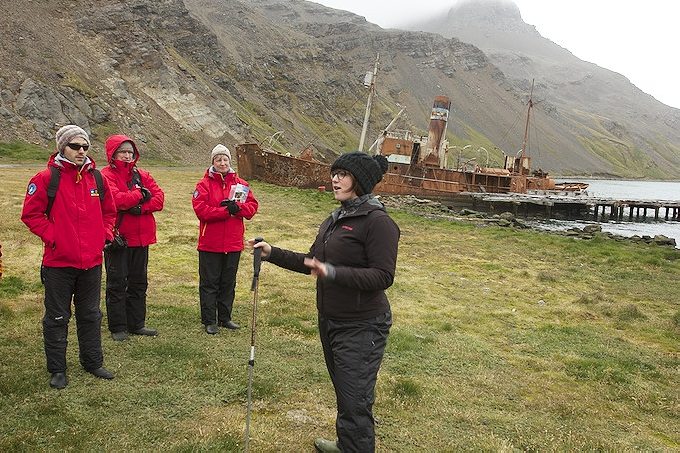
Ushuaia, the world’s southernmost city, is a full five days’ sail northwest of here at 14 knots. South Georgia is an unforgiving place, and its museum—which preserves the memory of whalers who once lived here, the 175,250 whales who died here, and the final chapters in the life of one of history’s most celebrated explorers—is at the literal end of the Earth.
This December will mark the 100th anniversary since Sir Ernest Shackleton set sail from this very spot on his ship, the Endurance. Along with 22 men and 69 dogs, Shackleton was trying to cross Antarctica. He failed spectacularly. Though exploration of the southern continent continues today—much of it done by people stationed with Paterson in South Georgia—Shackleton was the last in the line of the great terrestrial explorers that began with the Vikings, men who set out into the genuine unknown to fill in the planet’s blank spaces.
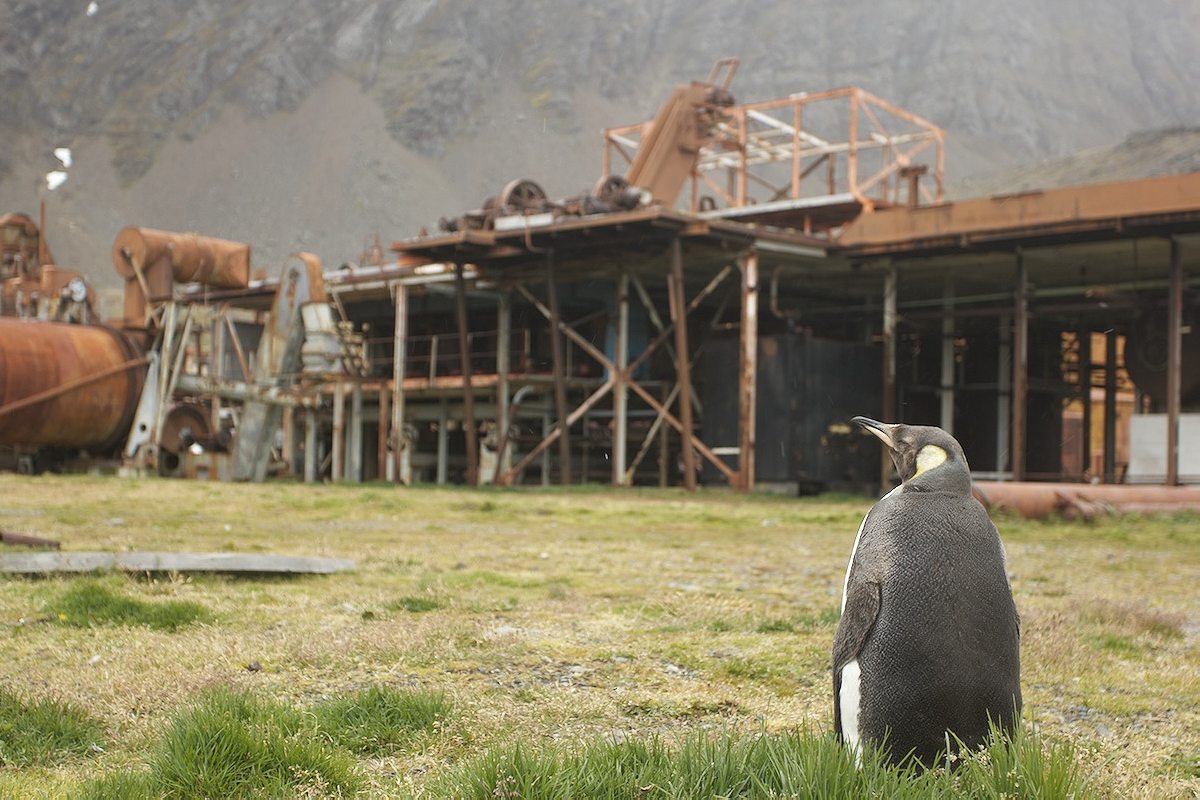
Shackleton is a hero of perfect ambivalence, a man filled with enough hubris to prompt him to take his men to meet almost certain disaster, but possessed of such extraordinary leadership skills to pull off a victory of mythological proportions in a story of man versus nature that ranks with the best tall tales. When I found out that South Georgia—the place at the beginning, middle, and end of Shackleton’s odyssey—was a place you could actually visit without the sort of hard-tack bona fides that are still required to go to Antarctica proper, I knew I had to see it for myself.
Approaching from the west, over the sedimentary mountains that form this sub-Antarctic archipelago, you walk through a rusted orange skyline of partially collapsed whale oil tanks to get to the harbor where Shackleton set off. The museum, housed in the villa built for the founder of the whaling station, Carl Anton Larsen, and his wife, three daughters and two sons, has bits of seal fur to feel, harpoon heads, and a snapshot of a smiling bearded man in a sweater who killed 6,000 whales.
It gets a few hundred visitors a year, mostly people on outlandish once-in-a-lifetime cruises, some on private yachts on extreme journeys. Suzanne and her boss, Sarah Lurcock, mostly hang out with the staff at King Edward Point, run by the British Antarctic Survey. Lurcock, who has lived here for eight months of the year since 1989, is married to the officer in charge. Most of the rest are bearded bachelors, here because life in London, Glasgow, or Bournemouth is boring or intolerable for one reason or another. They live on semi-annual “human packs” that are shipped in. “You wouldn’t believe what they can put in cans,” Suzanne says, riddling off a list running from asparagus to water chestnuts. Occasionally they eat a seal that gets caught in an outboard motor. The mail comes every six weeks.

The museum, run by the South Georgia Heritage Trust, bears witness to what happened from 1904 to1964, when South Georgia was whaling’s last gasp. The museum’s centerpiece is a replica of the James Caird, one of the Endurance’s two lifeboats. Twenty feet long, about 8 feet wide, it manages to look big in the small room. But it is small—too small to carry six men 800 miles for 15 days in the world’s most violent open seas during a hurricane that sank a 500-ton freighter.
But that’s just what it did, of course, after the Endurance hit the ice of which the whalers often spoke. Shackleton had been warned.
The team set sail Dec. 4, 1914. By Jan. 19, they were stuck. They used the Endurance as a station, supplementing their rations with the occasional penguin and sea lion and, as the situation deteriorated, dog, hoping that the thaw would free the ship. But as Shackleton wrote on Oct. 24, after his entire crew survived an Antarctic winter in the ship’s belly, a living quarter they nicknamed the Ritz, “The Endurance groaned and quivered as her starboard quarter was forced against the flow, twisting the sternpost and starting the heads and ends of planking. The ice had lateral as well as forward movement, and the ship was twisted and actually bent by the stresses. She began to leak at once.”
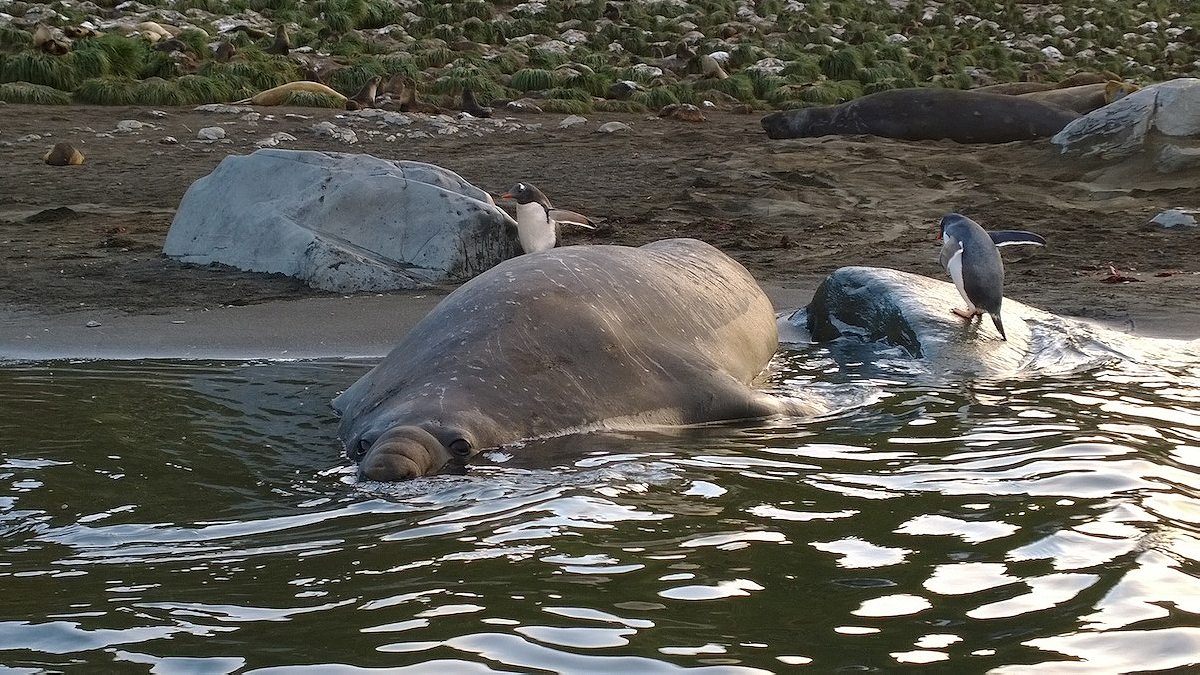
Any thought the men might have had of completing the expedition was dashed. Success, now, meant survival. A camp was struck on the ice, and a month later, the Endurance sank.
They camped on the floating ice for five months before it started to break. On April 9, the crew boarded two lifeboats and rowed for five days until they reached Elephant Island, 800 nautical miles from the closest help—the whalers in South Georgia. Two weeks later, Shackleton and five men got into the James Caird, named for one of the expedition’s donors. They sailed for 15 days. The James Caird made land on May 9, and in Stromness, a tiny and now-abandoned whaling station on South Georgia’s northern shore, Shackleton and his men finally found help.
Shackleton and two of his crew were the first to make it across this craggy, cavernous island by land, and few have done it since. It took the sailors 36 hours. In 1999, three expert mountaineers tried, including Reinhold Messner, the first man to climb Everest without oxygen and the first to climb all 14 of the world’s so-called eight-thousanders (mountains over 8,000 meters, or about 26,000 feet). It took them three days.
<center>***</center>
In March, the beginning of autumn in South Georgia, I climbed and stood on the ridge where Shackleton had, and looked across at the enormous Z agglomerated into the mountain across the bay that had let him know, in the low-lying fog, that he had led his men to the right place. It was a clear day and I took the easy way out, trundling the nose of the slope, just 50 meters east of the waterfall Shackleton and his men rappelled down, the fog so thick they didn’t know there was a safer way just to the right of them. From there, it’s a 20-minute scramble into Stromness, where Shackleton and his men saw their first scraps of civilization in more than two years.
Our ship was waiting for us in the bay, and so was his.
Shackleton came back, six years later, on another expedition. But as he waited for it to start, in his new ship in the harbor, he had a heart attack and died. His body was being shipped back to England, and had made it as far as Montevideo, when the caravan received a message from his wife saying that her husband would have wanted to be buried in South Georgia. Today, there’s a small cemetery on the side of a north-facing slope overlooking the station and the bay. There are white quadrangles marking a few dozen of the 200 or so whalers who died here, and a white cross over the body of Felix Artuso, an Argentinian killed by a Wasp missile fired from the new HMS Endurance as he climbed out of his submarine in the bay during the Falklands War.
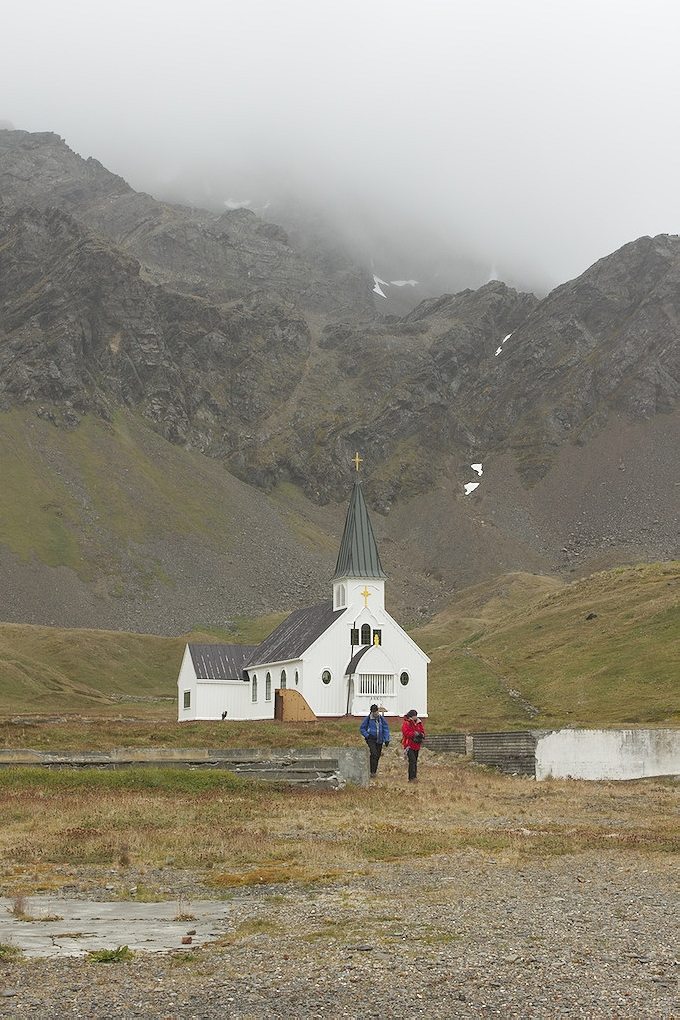
At the foot of the hill, pressed up against the white picket fence, is Shackleton, buried facing the south that made him.
My trip on the National Geographic Explorer is labeled an “expedition” rather than a cruise, because the waters are so unpredictable, the destination so unlikely. We hop into the inflatable black Zodiacs and land half a dozen times, in the Falklands and South Georgia, but skip another three or four because of high seas, fog, or katabatic and föhn winds that whip up to hurricane force in a minute, knocking penguins hilariously over before receding just as quickly. This is a tough part of the world, even for a 367-foot ship like ours, run by a company—Lindblad Expeditions—founded by the first man to take tourists down to this part of the world in the 1970s.

Not many vessels come down here, so when someone needs to get in, or out, they hop on a ship like this. When the Chasing Ice guys wanted to set up some new cameras in February, they took the Explorer. And Paterson, Lurcock, and the museum’s two other young staffers, Kris Allan and Josie Clark, are hitching a ride out with us since we’re the last ship to sail before winter. The 100 or so passengers, who pay as much as $15,000 a person to take a trip like this, underwrite its other functions, like James Caird did the Endurance.
The sail out was calm enough—10-foot seas at most—but on our way back the swells were 30 feet, and we left in a hurry, ahead of a storm that would have plumped them up to 60. One of the naturalists on board, who’d been sailing this route for years, told me about the last time a similar ship was caught in rough seas like that. Passengers were confined to their cabins. Every glass door in the place was shattered. A wave hit the side of the ship with such force that it crushed a porthole window, spraying a berth with glass and blowing in so hard the passengers couldn’t open their door to get out. Shackleton wrote about a wave like that hitting the James Caird, a rogue wave he was sure would swamp them, one that hit at night and gave the seasoned sailor nightmares years later.
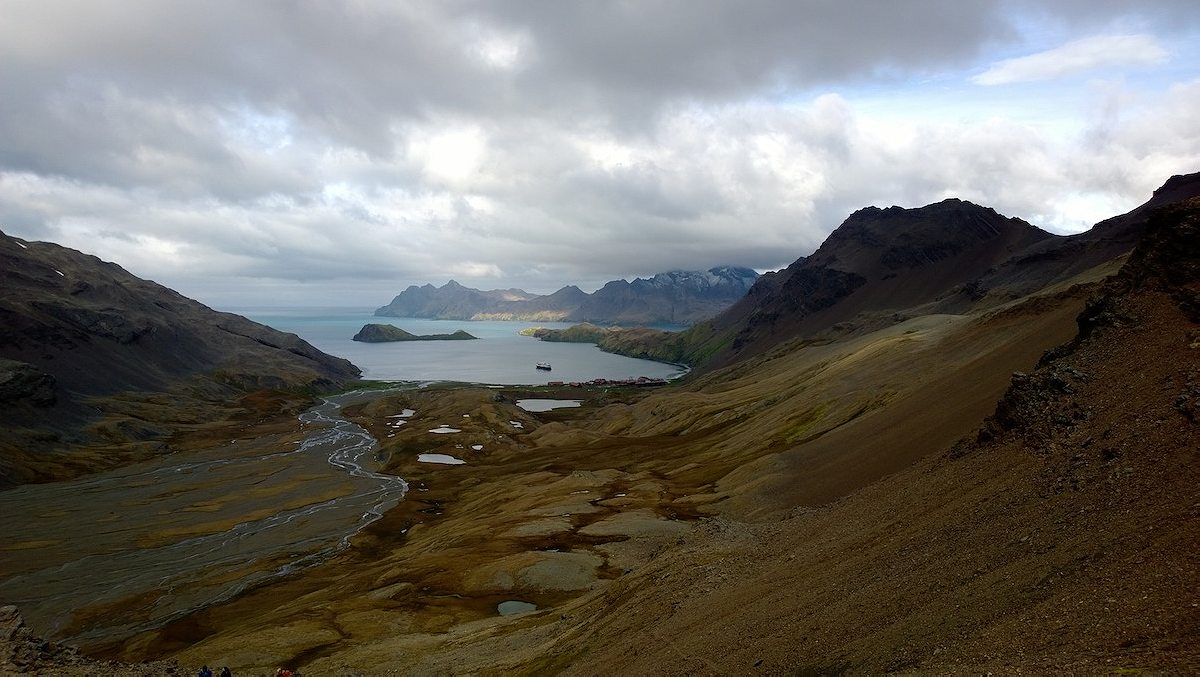
Thirty-foot seas were enough to keep me—and about two-thirds of the ship—flat in bed for most of the three days we weathered them. By the time we reached Ushuaia, I was hungry, and had a little sympathy for Shackleton and his men, who scooped up and stewed every baby albatross they could find when they finally made it to South Georgia.
There are millions of birds on these islands—albatrosses, penguins, cormorants, even ducks driven to scavenging carnivorousness by land too barren for seeds and seas too stormy to fish. With no terrestrial predators, the birds are fearless and curious, and will waddle right up to you. The gloriously painted king penguins occasionally poke at you with their long, elegantly arced, sharp beaks. According to Lurcock, it’s what most people come down here to see.

But those winds that knock them over, the porthole-bursting seas, the remoteness that means medical care can be days, even weeks away: That’s the real reason to journey here. It’s the closest you can get to the world in which Shackleton lived, the one that crushed him but didn’t beat him. Every one of his 22 men survived. It’s a remarkable story in any context, surviving in tents on the ice, an Antarctic winter, that 800-mile open-boat odyssey.
But down here, it seems more like myth.
